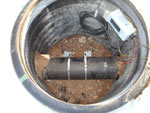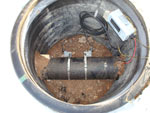
Closed Pipe System Replaces Open Ditch Irrigation

A flow meter in a manhole. Photo courtesy of MVIC.
The Montezuma Valley Irrigation Company (MVIC) in Cortez, Colo., coupled automation with intelligent design to increase the productivity of its irrigation system in southwestern Colorado.
MVIC provides irrigation water to 1,400 shareholders who are farming and ranching 37,500 acres in Colorado. The water comes from the Dolores River via two reservoirs, two main canals, and 17 distribution laterals. The canals and laterals cover 124 miles.
MVIC retained the services of AgriTech Consulting of Morrison, Colo., to determine the best method to minimize water loss in the May Lateral Canal. The team decided to replace five miles of open ditch irrigation canals with a poly pipe water distribution system.
The pipe system has 45 branches off the main supply line, which ranges from 12 to 36 inches in diameter and from 30 to 50 pounds-per-square-inch high density polyethylene (HDPE). The turnout pipes that serve each shareholder are also HDPE with a transition to polyvinyl chloride. Turnout pipe diameters range from 4 to 8 inches. Each branch turnout is supplied with an ultrasonic flow meter and two butterfly valves. The meter measures the amount of water passing through the turnout. MVIC controls the first butterfly valve, setting flows according to the number of shares of water allocated The shareholder uses the second butterfly valve to shut off or reduce water volume. Each meter is either solar or battery powered.
On older parts of the system, MVIC is using impeller flow meters that require annual maintenance and are subject to plugging. To reduce maintenance and eliminate plugging problems, the team decided to use a non-intrusive flow meter.
“After extensive review of many types of meters from various manufacturers, a decision was made to purchase ultrasonic flow meters from Dynasonics,” said Jim Siscoe general manager of MVIC. Dynasonics is a division of Racine Federated.
A number of factors entered into the decision to purchase the Model TFXL meters:
- it had the lowest installed cost, especially for larger pipe sizes;
- one meter could be used for many pipe sizes; and
- it provided 1 percent flow measurement accuracy.
Smaller turnouts aren’t solar powered or provided with continuous power by any other means. MVIC ditch riders instead power the flow meter with a portable 12-volt battery.
“While the flow meter is under battery power, the measured flow rate is used to manually adjust flow via the butterfly valve immediately downstream from the meter. Most of these smaller turnouts require only one setting per season, although some turnouts are adjusted during the season,” explained Siscoe.
Larger turnouts and main distribution lines are being equipped with solar-powered flow meters, allowing MVIC staff and shareholders to read continuous or totalized flow at any time.
Final project costs were $2.9 million. Annual savings are projected to be $2 million, calculated from using 1,000 acre feet less of water each year at an average price of $2,000/acre foot. These numbers would yield a payback period of about 18 months for the project, but the company is realizing immediate savings through creative financing. The project was funded with a low-interest loan from the Colorado Water Conservation Board, a grant from the Colorado River Salinity Forum, and company resources.
Operating experience over the past two years has been excellent. “Our shareholders were skeptical at first, but we’re now realizing the full potential of the system. We especially like the non-intrusive aspect of the flow meters which results in no maintenance, low cost, flexibility, and ease of installation. The Dynasonics flow meters are now our standard for both new and retrofit applications, particularly replacement of our impeller flow meters,” related Siscoe.
MVIC and AgriTech Consulting have received a $75,000 Conservation Innovation Grant from the U.S. Department of Agriculture Natural Resources Conservation Service to automate portions of the closed pipe irrigation network. Scope items for the grant include a solar-powered gate to control water level in the feeder canal and a wireless flow control and measurement system. The solar-powered gate is operating successfully for the second irrigation season. Flow control and measurement at two turnouts will be implemented via a wireless supervisory control and data acquisition (SCADA) system. This portion of the project will demonstrate flow control and measurement at a remote location where flow needs to be changed frequently throughout the irrigation season. The telemetry and computer equipment with associated software has been ordered and installed at the master control center. All of the new turnouts have ultrasonic flow meters that can transmit flow measurement data to the master control center at the MVIC office. The equipment has been well received by the shareholders and has laid the groundwork for further automation.
The closed pipe network project has been so successful that the U.S. Bureau of Reclamation is providing $2.1 million in stimulus grants to MVIC for construction of a second similar 7-mile pipeline project.
About the Author
Gerald W. Knudsen, P.E., is general manager at AgriTech Consulting. He can be reached at 303.697.2123 or at knudsen@wispertel.net.